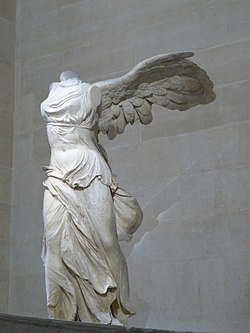One of the most famous Hellenistic sculptures that we haven't really discussed that much is the Winged Victory of Samothrace, a very important example of original Hellenistic culture that is currently at the Louvre. The sculpture depicts Nike, the goddess of victory, with giant wings, and was probably a monument to some military victory, though which one is a disputed subject. The monument was originally on a sculpture of a ship's prow, which was a somewhat common design for such sculptures. The statue was found in the ruins of the sanctuary at Samothrace, which a place devoted to a pantheon of gods. The statue likely dates from around 200 BC, based on the history of possible naval battles it could commemorate and the style of the sculpture.
The work shows off many of the Hellenistic characteristics that we have discussed in class. The sculpture is very dynamic, with Nike stepping forward powerfully. Her clothes drape around her in a very realistic way, and her wings are raised powerfully. The sculpting is very impressive and lifelike. Below are some pictures of this very important work of Hellenistic sculpture.



The right wing is actually a plaster restoration based on a mirror image of the left one, as shown in this picture.





No comments:
Post a Comment